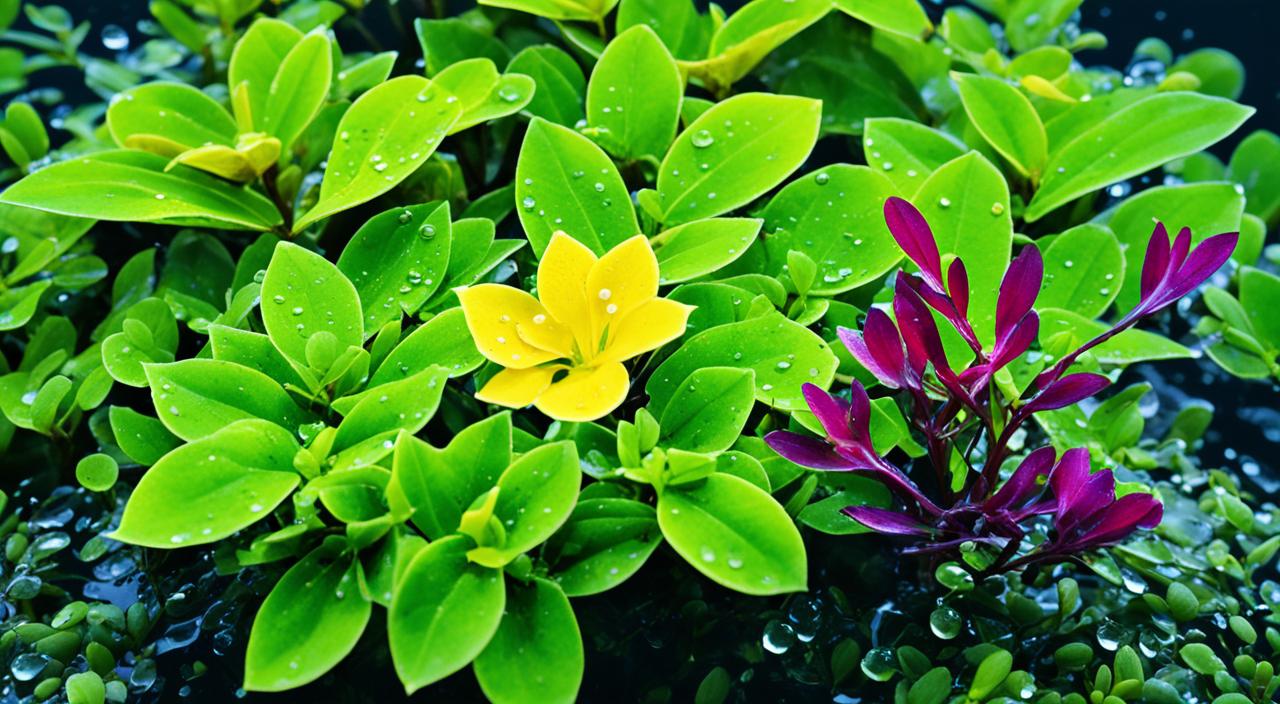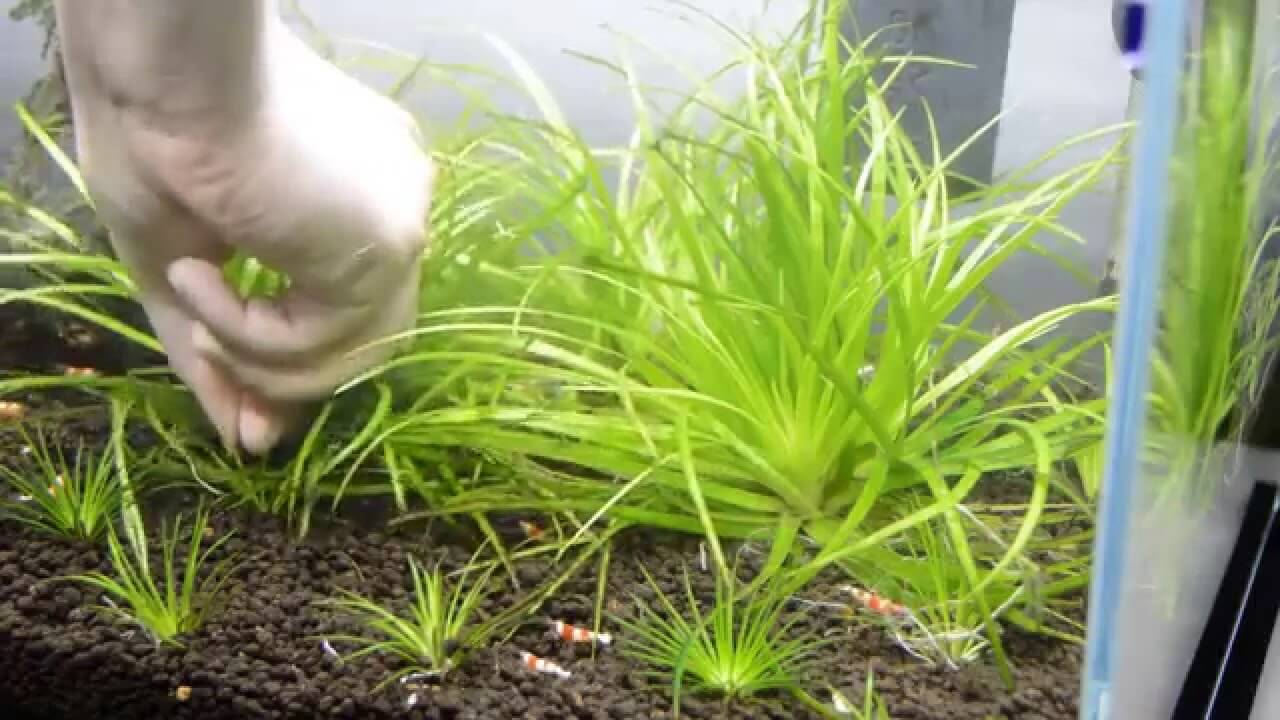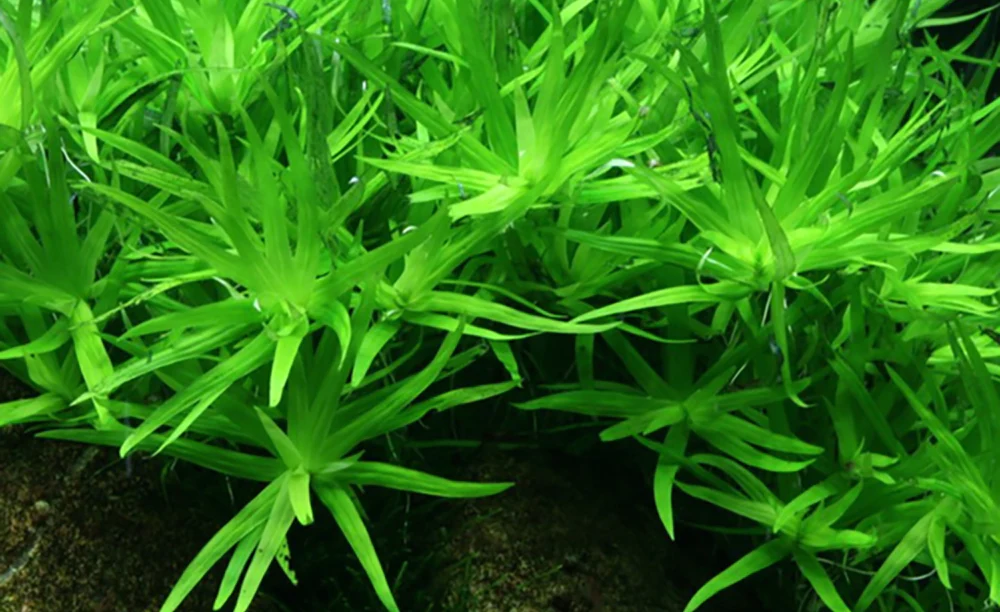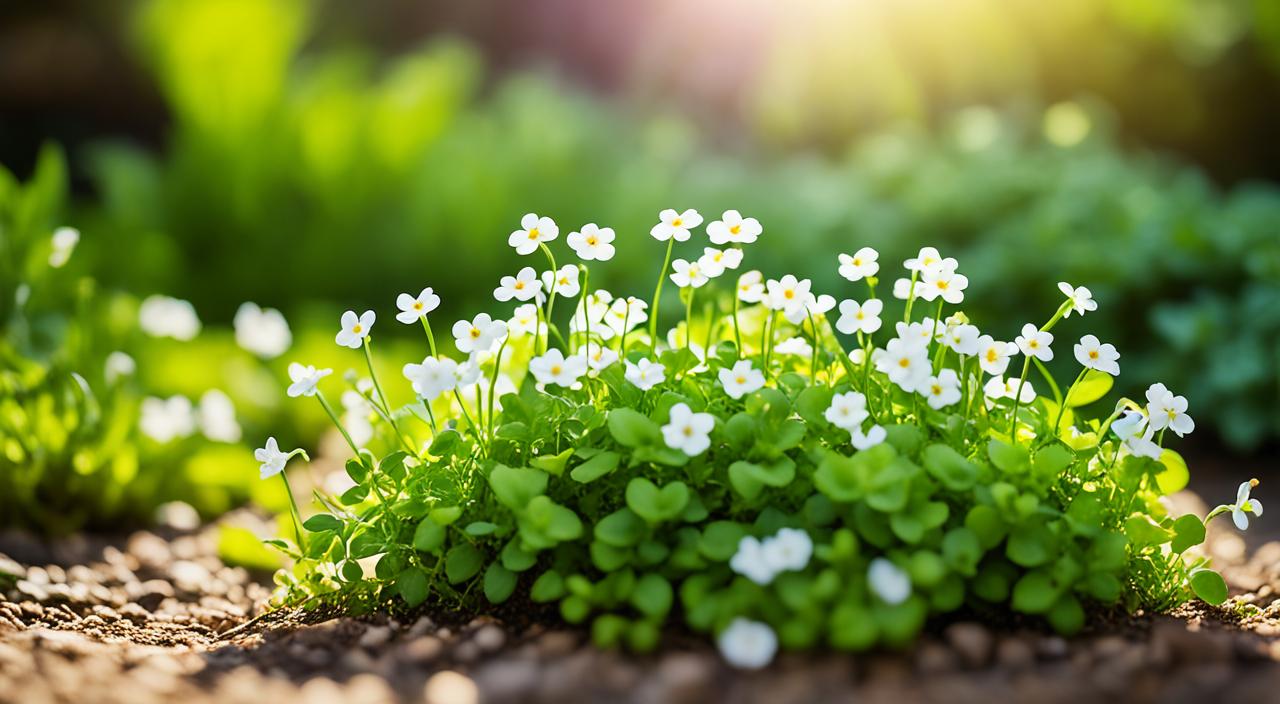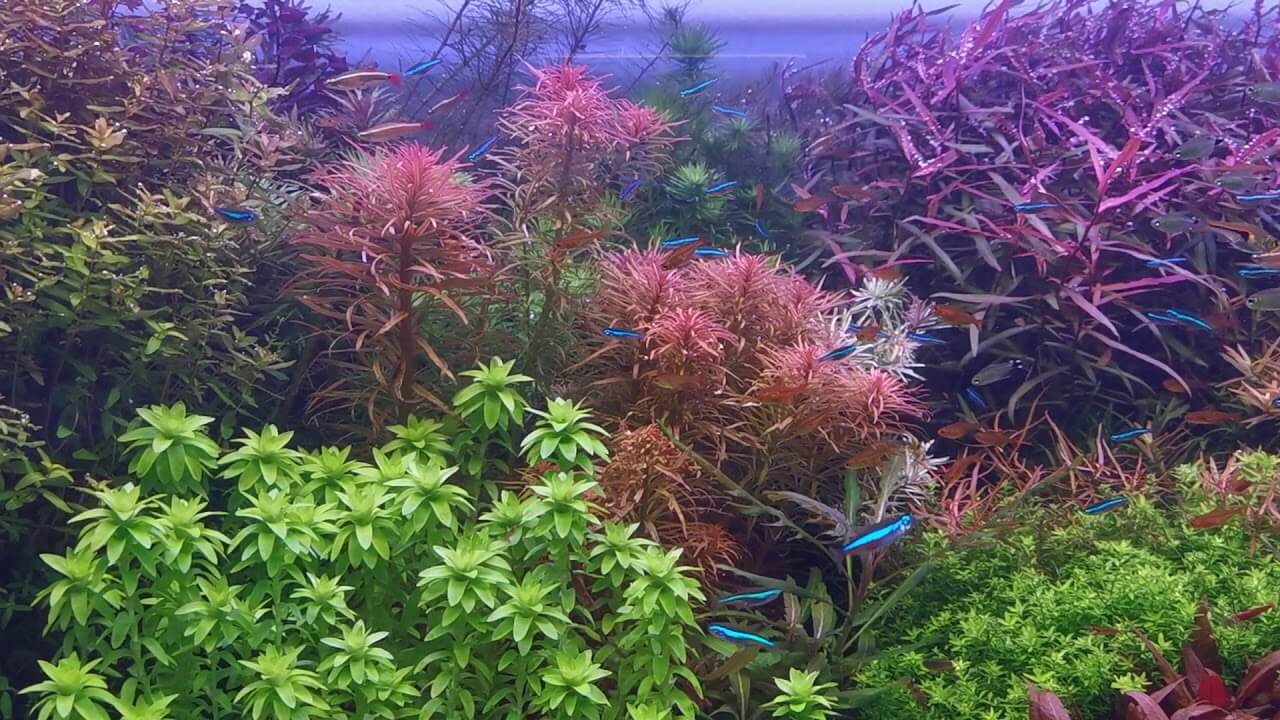As an avid aquarist, I’m always looking for stunning aquatic plants that can elevate the beauty of my freshwater aquarium. One such plant that has caught my attention is Ludwigia acuata, also called Needle Leaf Ludwigia. This versatile plant not only adds movement and dimension to my aquascape but also requires minimal care, making it a perfect choice for both beginners and experienced aquarists.
Ludwigia acuata features delicate green and red leaves that grow in pairs along the stem, creating a visually captivating effect. The colour of the leaves can range from green to red, depending on iron availability in the water. This plant can be grown either submerged or emersed, allowing you to design your aquascape according to your preference.
Ludwigia acuata requires high lighting and nutrient levels to achieve the desirable bright red colouration. While CO2 injection is not necessary, it can promote more robust growth. Propagation is simple and can be done by taking cuttings from the main stem and replanting them on the substrate.
Key Takeaways:
- Ludwigia acuata, or Needle Leaf Ludwigia, is a versatile aquatic plant for freshwater aquascaping.
- It features delicate green and red leaves that grow in pairs along the stem.
- The colour of the leaves can range from green to red, depending on iron availability in the water.
- High lighting and nutrient levels are necessary for the desirable bright red colouration.
- CO2 injection is not required, but it can promote more robust growth.
Brief Overview Of Ludwigia acuata
Ludwigia acuata, commonly known as Needle Leaf Ludwigia, is popular among aquarists for its beautiful appearance and ease of care. This aquatic plant features thin, pointed leaves that grow in opposite pairs along the stem. The leaves can be either green or red, depending on iron availability in the water. Needle Leaf Ludwigia can grow submerged or emersed, with the emersed form having round leaves, while the submerged form develops thin and orange to red leaves under high light and nutrient conditions. This plant is best suited for aquariums with medium to high lighting levels and can thrive in various water parameters. It is a moderate grower and can be propagated by taking cuttings from the main stem.
Ludwigia Acuata Information Table:
| Row Names | Descriptions |
|---|---|
| Scientific Name: | Ludwigia Acuata (Note: The correct scientific name might be intended as “Ludwigia arcuata”, a common misspelling is “acuata”) |
| Common Names: | Needle Leaf Ludwigia, Arcuata |
| Origin: | North America |
| Height: | 15-40 cm (6-16 inches) |
| Growth Rate: | Medium to Fast |
| Colour: | Green to Reddish |
| Aquarium Placement: | Midground to Background |
| Water Type: | Freshwater |
| pH: | 5.0-7.5 |
| Care Level: | Moderate |
| Light Requirements: | Root tabs and liquid fertilizers are recommended for nutrient supplementation |
| CO2 Requirements: | Recommended for optimal growth and color development |
| Temperature: | 20-28°C (68-82°F) |
| Flow Rate: | Moderate to High |
| Propagation: | Cuttings |
| Feed Type: | Root tabs and liquid fertilizers are recommended for nutrient supplementation. |
Origins And Habitat
Ludwigia acuata, also known as Needle Leaf Ludwigia, is a native plant of North America. It can be found in various freshwater habitats such as lakes, ponds, and slow-flowing streams. Ludwigia acuata grows submerged in shallow waters with ample access to sunlight in its natural habitat. This aquatic plant thrives in regions with a temperate climate.
Morphological Characteristics
Ludwigia acuata exhibits distinct physical features that contribute to its unique appearance. The plant is characterized by its thin, pointed leaves that grow in opposite pairs along the stem. The morphology of the leaves can vary, ranging from green to red, depending on the availability of iron in the water. This colour variation adds visual interest to aquariums and aquascapes.
With a height ranging from 10 to 20 inches, Ludwigia acuata can serve as a striking focal point in a planted tank. The plant has a moderate growth rate and can be submerged or emersed. When grown underwater under high light and nutrient conditions, the submerged form of Ludwigia acuata develops thinner and more colourful leaves.
The stem of Ludwigia acuata is typically sturdy and can support lateral branches when pruned regularly. This allows for shaping and creating desired aesthetics within the aquarium. Overall, the morphological characteristics of Ludwigia acuata make it a versatile and appealing choice for aquarists and aquascapers.
Placement And Lighting
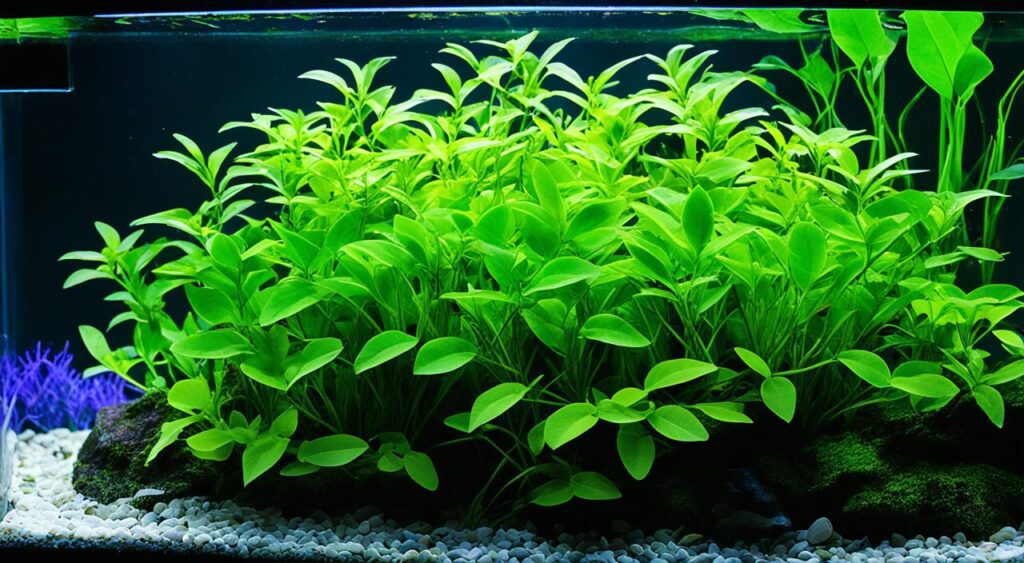
Ludwigia acuata, also known as Needle Leaf Ludwigia, is a versatile and visually appealing aquatic plant that can enhance the beauty of any freshwater aquarium. When considering the placement of Ludwigia acuata in your tank, it is best positioned in the mid- to background to serve as a bushy filler. This placement adds depth and dimension to the overall aquascape, creating a stunning visual effect.
For Ludwigia acuata to thrive and exhibit its vibrant colours, providing the proper lighting is crucial. Medium to high lighting is recommended to ensure optimal growth and colouration. Adequate lighting promotes healthy photosynthesis and brings out the best colouration in the plant’s leaves.
Regarding the lighting requirements of Ludwigia acuata, it is essential to note that higher levels of iron in the water can enhance the red tones in the leaves, leading to a more striking appearance. Therefore, maintaining appropriate iron levels can contribute to achieving the desired vibrant colouration.
Unlike some other aquatic plants, Ludwigia acuata does not require CO2 injection for cultivation, making it an excellent choice for aquarists who prefer a low-tech setup. However, it is worth mentioning that CO2 supplementation can promote more robust growth and overall health of the plant. Therefore, if you choose to use CO2 injection, it is vital to monitor and adjust the CO2 levels to maintain a stable and appropriate environment for Ludwigia acuata.
Ludwigia acuata is a resilient plant that can tolerate a wide range of water parameters. However, to ensure the plant’s well-being and longevity, it is essential to maintain stable conditions, including appropriate lighting and other necessary nutrients.
| Placement | Lighting | CO2 Injection |
|---|---|---|
| Mid- to background | It is not necessary, but it can promote robust growth | It is not required, but it can encourage robust growth |
What Are Good Tank Mates?
Ludwigia acuata, or Needle Leaf Ludwigia, can coexist peacefully with various fish species, making it a versatile addition to community aquariums. When choosing tank mates for Ludwigia acuata, it is crucial to consider their compatibility and temperament. Here are some excellent tank mates that can be housed with Ludwigia acuata:
Good Tank Mates
- Tetras: Peaceful and schooling fish, such as Neon Tetras or Cardinal Tetras, can create a vibrant and lively environment with Ludwigia acuata.
- Rasboras: Species like Harlequin Rasboras or Chili Rasboras can peacefully coexist with Ludwigia acuata, adding movement and colour to the aquarium.
- Guppies: These small, colourful fish are known for their peaceful nature and can thrive alongside Ludwigia acuata.
- Corydoras Catfish: Bottom-dwelling fish like Corydoras Catfish can help keep the substrate clean while peacefully cohabiting with Ludwigia acuata.
Fish Species To Avoid
While Ludwigia acuata is generally compatible with a wide range of fish species, certain fish should be avoided pairing with this aquatic plant. These species may exhibit aggressive behaviour, have specific dietary requirements, or disrupt the delicate balance of the planted aquarium. Here are some fish species to avoid with Ludwigia acuata:
- Aggressive Cichlids: Cichlids, exceptionally more extensive and aggressive species, can damage or uproot Ludwigia acuata due to their territorial nature.
- Fin-Nipping Fish: Some species, such as Tiger Barbs or Red Eye Tetras, tend to nip at the fins of other fish and may cause harm to Ludwigia acuata.
- Herbivorous Fish: Fish primarily feeding on plants, such as Silver Dollars or Goldfish, may consume or damage Ludwigia acuata, compromising its growth and overall health.
By selecting compatible tank mates and avoiding aggressive or herbivorous fish species, you can create a harmonious aquatic environment that allows Ludwigia acuata to thrive and showcase its beauty.
Feeding (Fertilization)
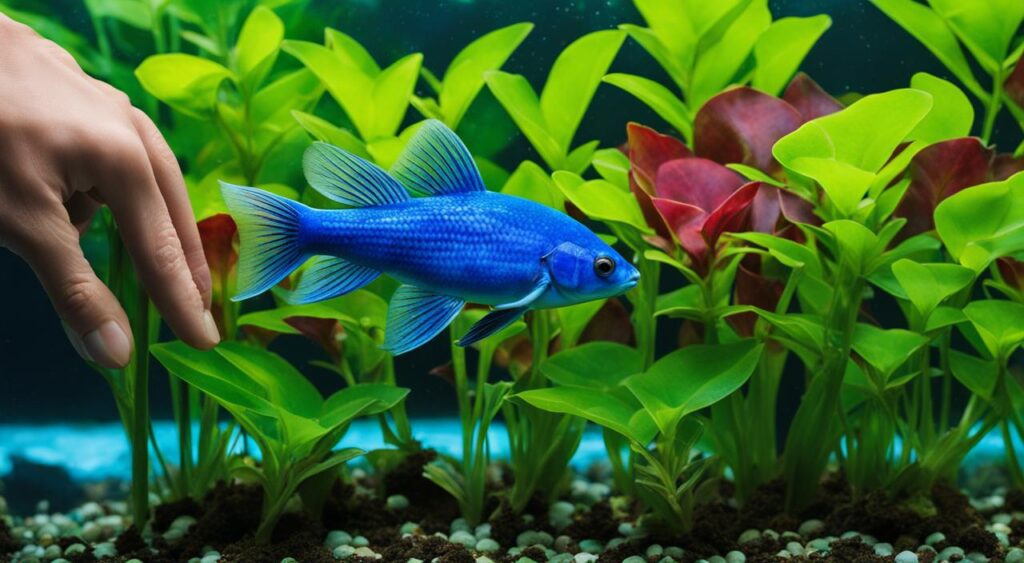
Ludwigia acuata, or Needle Leaf Ludwigia, is a nutrient-hungry plant that can benefit from additional fertilization to ensure optimal growth and vibrant colouration. While it can obtain most of its nutrients from the water column, supplementing its diet with liquid or substrate fertilizers can balance essential nutrients. These fertilizers typically contain a mix of macronutrients such as nitrogen, phosphorus, and potassium and micronutrients like iron, magnesium, and trace elements.
The dosage and frequency of fertilization will vary depending on the specific product and the needs of your aquarium. Following the manufacturer’s instructions is essential to avoid over-fertilization, which can lead to algae problems and stress the plant. Regularly monitoring the plant’s response to fertilization can help you adjust the dosage and frequency accordingly.
Remember that Ludwigia acuata has a moderate growth rate and high nutrient requirements, so adequate fertilization is crucial for its health and vitality. A well-nourished plant will exhibit lush foliage, intense colours, and robust growth, enhancing the overall beauty of your aquascape.
Regular water changes can also help maintain optimal nutrient levels and prevent the accumulation of waste products that can hinder the plant’s growth. Combining proper fertilization and water changes can create a thriving environment for your Ludwigia acuata.
Feeding Ludwigia acuata through fertilization is essential to fulfil its nutrient requirements and promote healthy growth. By supplementing its diet with the right balance of fertilizers and maintaining proper water parameters, you can enjoy the stunning beauty of this aquatic plant in your aquarium.
CO2 Injection
Ludwigia acuata can grow well without CO2 supplementation, but injecting CO2 into the aquarium can promote more robust growth and colouration. CO2 supplementation is especially beneficial for achieving the desirable bright red colouration of Ludwigia acuata’s leaves. Various types of CO2 systems are available, each with advantages and considerations.
Types of CO2 Systems
1. Pressurized CO2 Systems: These systems involve the use of pressurized carbon dioxide in a controlled manner. They typically consist of a CO2 cylinder, regulator, solenoid valve, and diffuser. Pressurized CO2 systems provide a stable and consistent release of CO2, allowing precise control over the amount of carbon dioxide dosed into the aquarium. This ensures that the levels of CO2 remain within the optimal range, leading to healthier and faster plant growth. Although pressurized CO2 systems may require a higher initial investment, they offer long-term reliability and efficiency.
2. DIY Yeast CO2 Setups: These setups utilize a DIY approach involving fermentation yeast and sugar to produce carbon dioxide. The CO2 is then diffused into the aquarium using a simple DIY reactor or diffuser. DIY yeast CO2 setups are more budget-friendly than pressurised systems, requiring fewer specialized components. However, they require regular maintenance to replace the yeast and sugar solution as they become depleted. Additionally, the CO2 output may not be as consistent or controllable as with pressurized systems, which can result in fluctuations in CO2 levels and growth rates.
When choosing a CO2 system for Ludwigia acuata, consider factors such as personal preferences, budget, and the specific needs of your aquarium. Pressurized CO2 systems offer more stability and control, ideal for advanced or more extensive setups. DIY yeast CO2 setups are cost-effective for smaller tanks or beginners experimenting with CO2 injection.
Remember to monitor the CO2 levels carefully and adjust the dosage accordingly to avoid overdosing, which can harm your aquarium’s inhabitants. CO2 supplementation should always be combined with proper lighting, fertilization, and overall maintenance for optimal results.
Care
Proper care is essential for maintaining the health and vitality of Ludwigia acuata in your aquarium. This section will cover the critical aspects of caring for this beautiful aquatic plant, including planted tank parameters, water quality, filtration, and flow requirements.
Planted Tank Parameters
Ludwigia acuata can thrive within a wide range of water parameters. Maintaining stable and appropriate conditions is important to ensure optimal growth and health. The following parameters are recommended for Ludwigia acuata:
| Parameter | Ideal Range |
|---|---|
| pH | 6.5-7.5 |
| Temperature | 70-82°F |
| Hardness | 3-8 dKH |
Water Quality
Providing optimal water quality is crucial for the well-being of Ludwigia acuata. Regularly test the water parameters such as pH, ammonia, nitrite, and nitrate levels to ensure they are within acceptable ranges. Consistent water changes, proper filtration, and maintaining a clean substrate will help maintain water quality and prevent the accumulation of harmful substances.
Filtration
Effective filtration is essential for a healthy aquatic environment. Choose a filtration system suitable for the size of your aquarium and ensure that it provides adequate mechanical and biological filtration. Regularly clean and maintain the filter to prevent debris build-up and ensure optimal performance.
Flow
Ludwigia acuata benefits from a moderate flow of water within the aquarium. Adequate water movement helps nutrient distribution and prevents stagnant areas in the tank. Consider using a water pump or adjusting the positioning of the filter outlet to achieve the desired flow.
Implementing and maintaining appropriate tank parameters, water quality, filtration, and flow will create an ideal environment for Ludwigia acuata to thrive and showcase its vibrant colours and lush growth.
Aquarium Maintenance
Proper aquarium maintenance is essential to ensure the health and vitality of Ludwigia acuata. This includes regular testing of water conditions, setting up the aquarium tank, and employing effective propagation methods.
Testing Water Conditions
Regularly testing the water parameters is crucial for the well-being of Ludwigia acuata. Monitoring pH, temperature, ammonia, nitrite, and nitrate levels is recommended. This can be done using test kits specifically designed for aquariums. Maintaining appropriate water conditions will promote the growth and overall health of the plant.
How To Set Up Your Aquarium Tank
Properly setting up your aquarium tank is essential in creating a suitable environment for Ludwigia acuata. Start by ensuring the tank is clean and free from any contaminants. Next, add a layer of nutrient-rich substrate to provide essential minerals for the plant’s growth. Install an efficient filtration system to maintain water quality and adequate flow. Finally, carefully introduce Ludwigia acuata to the tank, paying attention to its placement and lighting requirements.
Propagation Methods
Propagation reproduces Ludwigia acuata to expand or share your plant collection with other enthusiasts. One standard method is taking cuttings from the plant’s main stem and replanting them in the substrate. Ensure the cuttings have sufficient light, nutrients, and water conditions for successful growth. With proper care, Ludwigia acuata can be easily propagated, allowing you to enjoy a thriving aquatic garden.
Health And Disease
Signs Of Good Health
Healthy Ludwigia aquatic plants exhibit vibrant colours, firm leaves, and steady growth. The plant’s leaves should be free from discolouration, holes, or signs of decay. New shoots and lateral branches indicate active development and a healthy plant.
Signs Of Poor Health
Signs of poor health in Ludwigia acuata can include pale or faded colours, wilting or drooping leaves, thin and fragile stems, and stunted growth. Discoloration, holes, or rotting in the leaves indicate poor plant health.
Common Health Issues And Treatment
Several common health issues can affect Ludwigia acuata. These include nutrient deficiencies, such as iron deficiency, which can cause yellowing or pale leaves. Poor water quality, high ammonia or nitrate levels, and improper lighting can also negatively impact the plant’s health. Treatment for these issues usually involves addressing the underlying cause, such as adjusting nutrient levels, improving water quality, and providing appropriate lighting conditions.
Plant Pests
Ludwigia acuata is susceptible to various pests that can harm its health and appearance. Common plant pests affecting Ludwigia acuata include snails, aphids, and algae. Snails can feed on the plant’s leaves, leaving behind visible damage. Aphids can suck sap from the plant, causing wilting and stunted growth. Algae can compete with the plant for resources and cover its leaves, affecting its photosynthesis ability. Proper pest prevention and control measures, such as maintaining a clean tank, introducing natural predators, and using algae control methods, can help protect Ludwigia acuata from these pests.
Summary
Ludwigia acuata, or Needle Leaf Ludwigia, is a versatile and stunning aquatic plant that can bring life to any freshwater aquarium. With its vibrant colours and unique leaf structure, Ludwigia acuata adds movement and dimension to aquascapes, creating visually appealing underwater gardens.
This plant is relatively easy to care for and can adapt to a wide range of water parameters, making it suitable for both beginner and experienced aquarists. It can thrive in various lighting conditions, but providing high-intensity lighting can bring out the best in its red colouration, creating a striking focal point in the aquarium.
While CO2 injection is not necessary for the growth of Ludwigia acuata, it can help promote more robust growth and enhance the plant’s overall health. Regular maintenance, including water testing, proper filtration, and nutrient supplementation, is crucial for ensuring this plant’s vitality and long-term success in the aquarium.
With its versatility, beauty, and relative ease of care, Ludwigia acuata is a fantastic choice for aquarists looking to create a visually stunning and dynamic freshwater aquascape.
FAQ
What is Ludwigia acuata?
Ludwigia acuata, also known as Needle Leaf Ludwigia, is an aquatic plant that adds movement and dimension to aquariums. It has delicate green and red leaves that grow in pairs along the stem.
Where is Ludwigia acuata native to?
Ludwigia acuata is native to North America, where it can be found in various freshwater habitats such as lakes, ponds, and slow-flowing streams.
What are the characteristics of Ludwigia acuata?
Ludwigia acuata has thin, pointed leaves that can be green or red, depending on the iron availability in the water. It can grow submerged or emersed and has a moderate growth rate.
How should Ludwigia acuata be placed in an aquarium?
Ludwigia acuata is best placed in the mid- to background of an aquarium to serve as a bushy filler.
What lighting conditions does Ludwigia acuata require?
Ludwigia acuata thrives in aquariums with medium to high lighting levels.
What are good tank mates for Ludwigia acuata?
Ludwigia acuata can coexist peacefully with various fish species, including tetras, rasboras, guppies, and corydoras catfish. It can also be paired with peaceful invertebrates like shrimp and snails.
How should Ludwigia acuata be fed?
Ludwigia acuata can derive most of its nutrients from the water column, but additional fertilization may be necessary. Liquid or substrate fertilizers containing essential nutrients can be used to supplement its diet.
Is CO2 injection necessary for Ludwigia acuata?
CO2 injection is not necessary for the cultivation of Ludwigia acuata, but it can promote more robust growth.
What tank parameters are suitable for Ludwigia acuata?
Ludwigia acuata can thrive in a pH range of 6.5-7.5, a temperature range of 70-82°F, and a hardness range of 3-8 dKH.
How should I maintain water conditions for Ludwigia acuata?
Regularly testing the water parameters, including pH, temperature, ammonia, nitrite, and nitrate levels, is important to ensure the health of Ludwigia acuata.
How can Ludwigia acuata be propagated?
Ludwigia acuata can be propagated by taking cuttings from the main stem and replanting them in the substrate.
What are the signs of good health in Ludwigia acuata?
Healthy Ludwigia acuata plants exhibit vibrant colors, firm leaves, and steady growth. New shoots and lateral branches indicate a healthy plant.
What are common health issues and treatment for Ludwigia acuata?
Common health issues in Ludwigia acuata include nutrient deficiencies and plant pests. Treatment may involve adjusting nutrient levels and using appropriate pest control methods.
Can Ludwigia acuata be affected by plant pests?
Yes, Ludwigia acuata can be affected by plant pests. Common pests include snails and algae. Proper maintenance and pest control measures can help avoid infestations.
What is a summary of Ludwigia acuata care?
Ludwigia acuata is an easy-to-care-for aquatic plant that requires medium to high lighting levels and nutrient supplementation. CO2 injection is not necessary but can promote more robust growth. This versatile plant can coexist with various fish species and is propagated by cuttings. Regular water testing and maintenance are key to its health and vitality.

